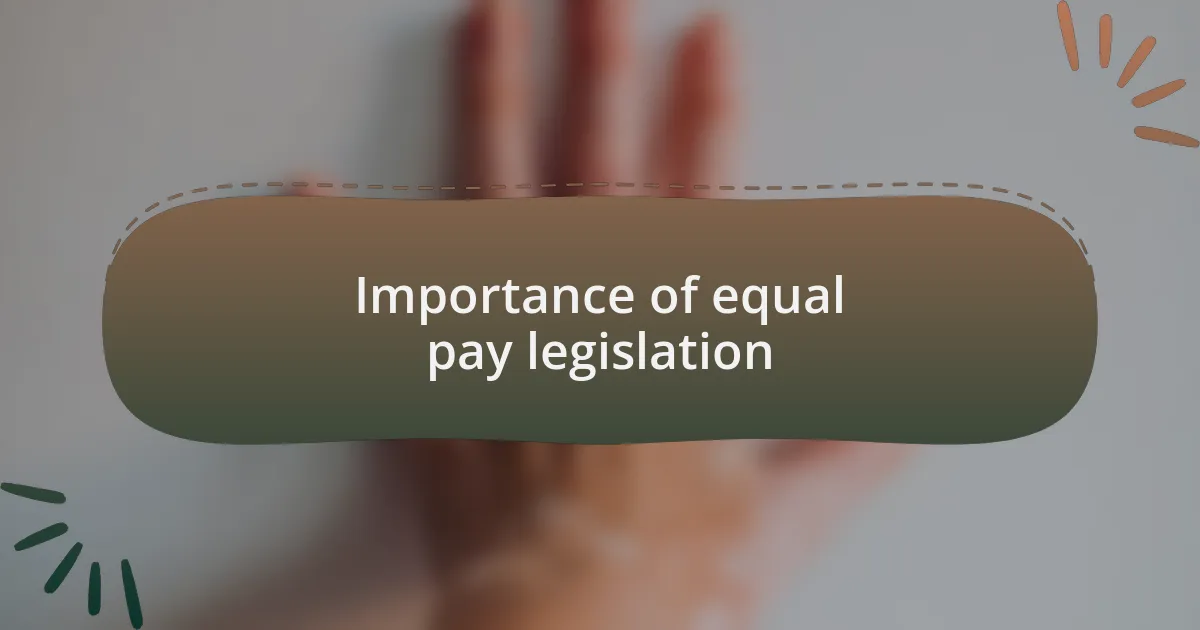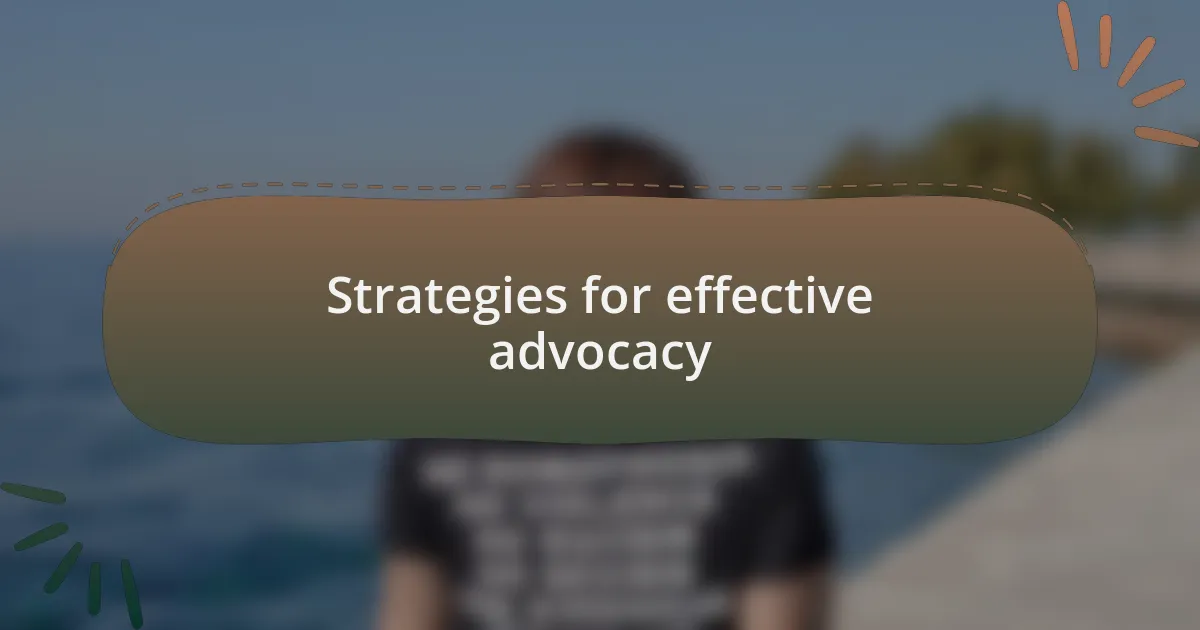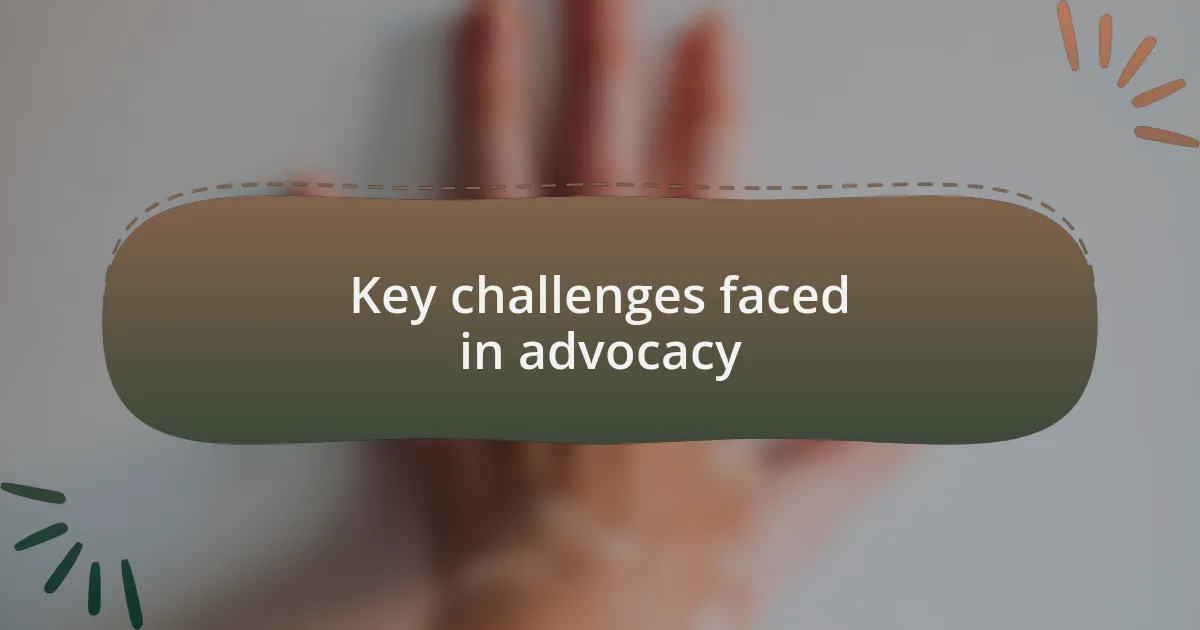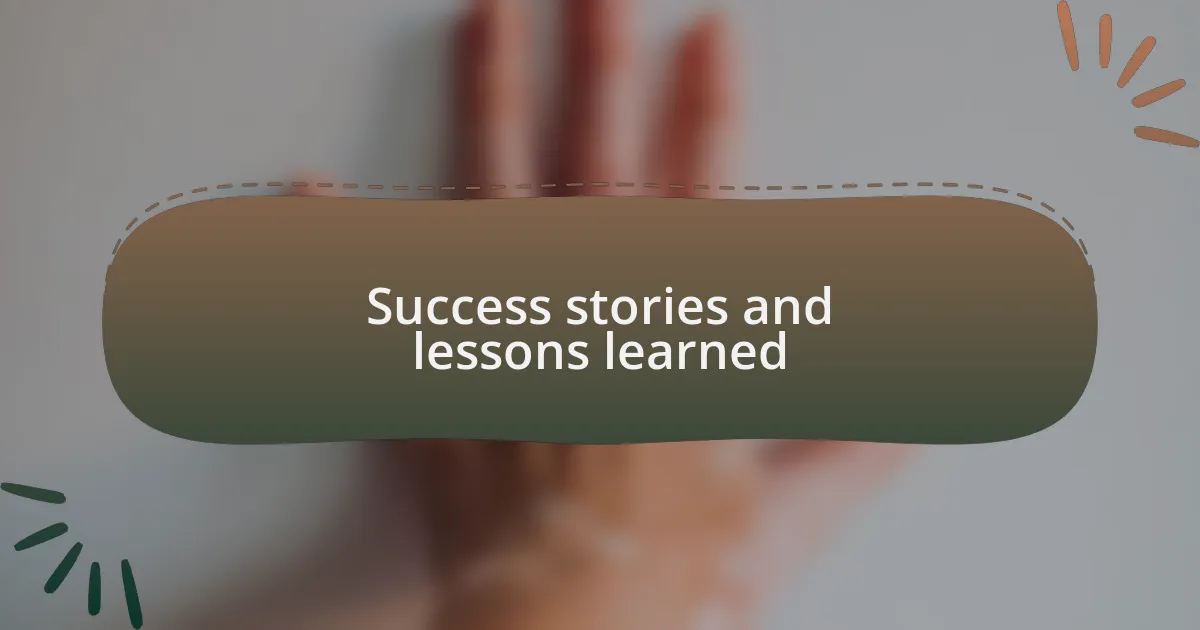Key takeaways:
- Advocating for gender equality highlights the personal toll of wage disparities and the need for systemic change.
- Equal pay legislation is vital for combating discrimination, closing the wage gap, and fostering a more equitable economy.
- Effective advocacy combines compelling narratives, coalition-building, and leveraging social media to amplify voices.
- Success in advocacy often requires patience, resilience, and collaboration with various stakeholders, including local businesses.

Understanding gender equality advocacy
Gender equality advocacy is fundamentally about ensuring that individuals, regardless of their gender, have equal rights and opportunities. When I first got involved in this movement, I felt a sense of urgency—why should someone’s pay depend on their gender? This question ignited my passion and drove me to study the disparities that persist in our workplaces.
As I immersed myself in the issue, I learned that gender equality is not just a legal or economic concern; it’s a deeply personal one. I recall speaking to a colleague who had to fight for equal pay for years, and her frustration was palpable. It made me realize how this issue affects real lives, built on the dreams and aspirations of countless individuals who deserve the same recognition as their peers.
Advocating for gender equality means amplifying voices that are often silenced and bringing attention to systemic injustices. I often reflect on the moments when we gather to share our stories; it’s powerful. Are we not all entitled to fair treatment? The answer is a resounding yes, and the journey toward achieving that goal is one we must navigate together.

Importance of equal pay legislation
Equal pay legislation serves as a crucial safeguard against gender discrimination in the workplace. I remember one instance when I attended a local meeting on wage disparities. A young woman shared her struggle to negotiate her salary, feeling undervalued compared to her male counterparts. Hearing her story reinforced my belief that legislation can empower individuals, giving them the tools to demand what they rightfully deserve.
Moreover, the implementation of equal pay laws helps to close the gender wage gap over time. During my advocacy, I observed how workplaces began adopting transparent salary practices in response to new regulations. It’s fascinating to see how these laws can gradually shift company cultures, leading to fairer assessments of employee contributions. Can you imagine the impact if every organization embraced such changes?
As I reflect on these experiences, I realize that equal pay legislation not only affects individuals but also strengthens the economy as a whole. When everyone is compensated fairly, families thrive, communities grow, and we all benefit from a more equitable society. Does it not make sense that an inclusive workforce boosts overall productivity? In my view, this legislation is not just a matter of fairness; it is essential for sustainable development.

Strategies for effective advocacy
Advocacy requires a clear and compelling narrative. I remember crafting a speech for a community event, focusing on the tangible benefits of equal pay. Sharing concrete examples, like how a local business saw improved employee morale and productivity after adopting fair pay practices, made the concept resonate with the audience. Have you ever noticed how stories can transform statistics into relatable experiences?
Building coalitions is another impactful strategy. I found that partnering with local organizations created a stronger voice for our cause. We organized joint campaigns that amplified our message and reached a broader audience. It’s incredible how collaboration can turn individual efforts into a united front, drawing more attention to the critical issue of equal pay.
Lastly, harnessing social media for advocacy is a game changer. I discovered that by sharing personal experiences and success stories online, we could reach people far beyond our immediate circles. Engaging with followers through polls and discussions not only raised awareness but also encouraged individuals to join the conversation. Have you ever thought about how a single tweet could spark a larger movement?

My personal journey in advocacy
Advocating for equal pay has been a deeply personal journey for me. I still recall the moment I realized how wage disparities affected not just individuals, but entire families. It struck me when a close friend shared how financial stress from her underpaid job was impacting her children’s education. How could I sit idly by while so many faced similar struggles?
As I dove deeper into advocacy, I learned the power of personal stories. One relatable instance was when I spoke at a panel discussion; I shared my own experiences of being overlooked for promotions despite my hard work. The feedback I received was overwhelming. It was clear that many in the audience had experienced this form of inequality themselves. Have you ever felt the weight of being undervalued in a professional setting?
Over time, I realized that effective advocacy isn’t just about raising awareness—it’s about igniting passion. I still remember the energy in the room during a rally where we united hundreds of voices, each with their own story. It was this collective spirit that reinvigorated my commitment to the cause. How powerful is it to see so many standing together for a shared goal? That moment made me believe even more deeply in the importance of our fight for equal pay.

Key challenges faced in advocacy
Advocacy for equal pay is not without its hurdles. One of the most pressing challenges I’ve encountered is overcoming entrenched biases. I remember attending a local government meeting where I presented data on wage gaps. The dismissive reactions from some officials were disheartening. How can we expect progress if decision-makers refuse to acknowledge the data in front of them?
Another significant challenge lies in mobilizing support. It’s easy to feel overwhelmed by the enormity of the issue and the apathy that sometimes surrounds it. During one campaign, I organized a small focus group to discuss strategies for community engagement. To my surprise, many participants felt they lacked the knowledge to advocate effectively. Why should anyone feel that their voice doesn’t matter in such an important cause?
Ultimately, navigating the complex landscape of advocacy requires resilience. There were times when I wondered if my efforts were making any difference at all. Yet, after attending a workshop hosted by experienced advocates, I learned about the importance of building coalitions. When we come together, sharing strengths and resources, that’s when real change can happen. Have you ever witnessed the impact of unity in a cause? It can be incredibly transformative.

Success stories and lessons learned
Success stories in advocating for equal pay often come from unexpected places. I vividly recall a local campaign where we gathered testimonials from women in various industries, sharing their stories of inequality. The collective power of these voices not only resonated with the community but also captured the attention of local media. It was a turning point for us—how often do we underestimate the impact of personal stories?
One of my biggest lessons was realizing the importance of patience. There was a moment during a town hall meeting when I boldly presented our petition for equal pay legislation. It felt like a monumental step, but the reality was that change takes time. Reflecting on that experience, I learned that celebrating small victories along the way helps maintain momentum. Have you ever felt that you were on the cusp of change, only to discover it requires more endurance than you anticipated?
Another success stems from collaboration with allies in the business community. I partnered with a few local employers to develop an equal pay certification program. This initiative not only raised awareness but also showcased companies willing to lead by example. It’s fascinating how engaging with businesses can illuminate paths to change—have you thought about how partnerships might amplify advocacy efforts?